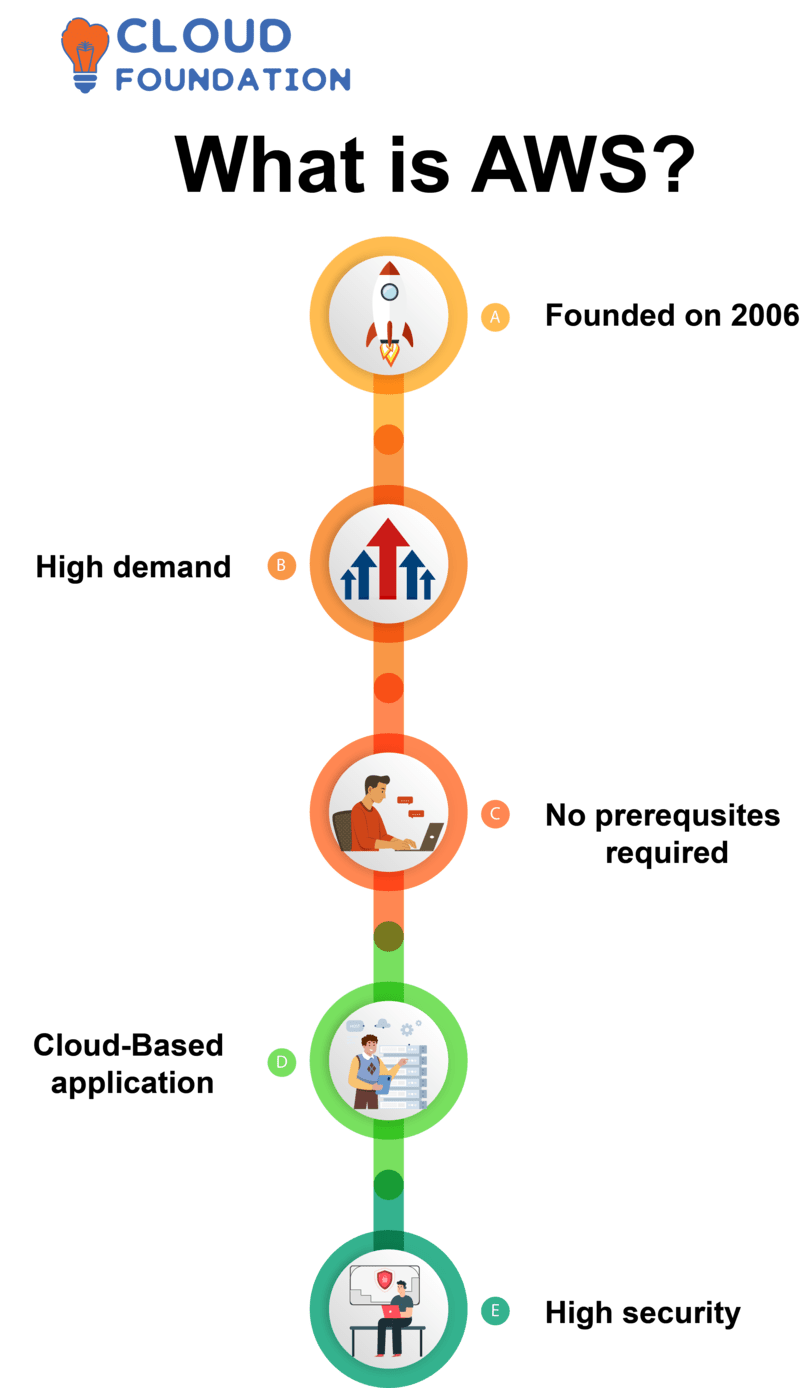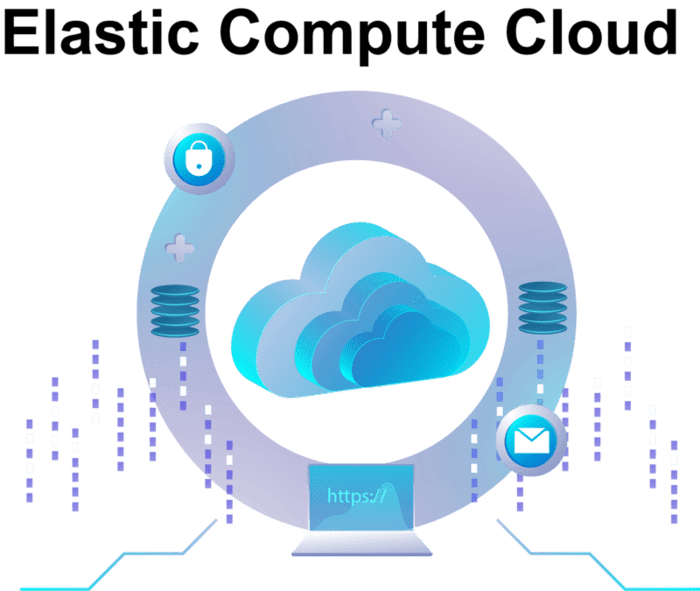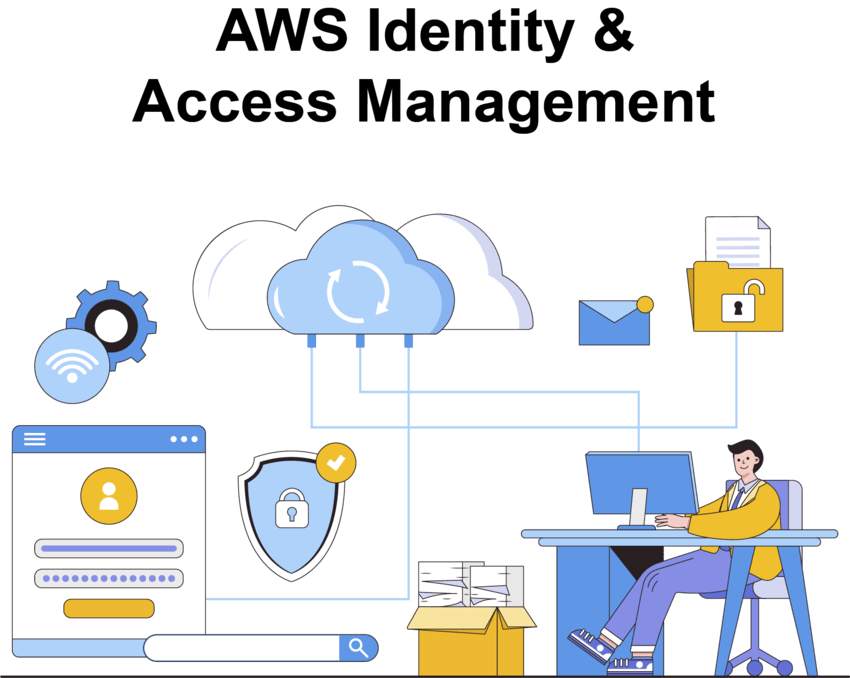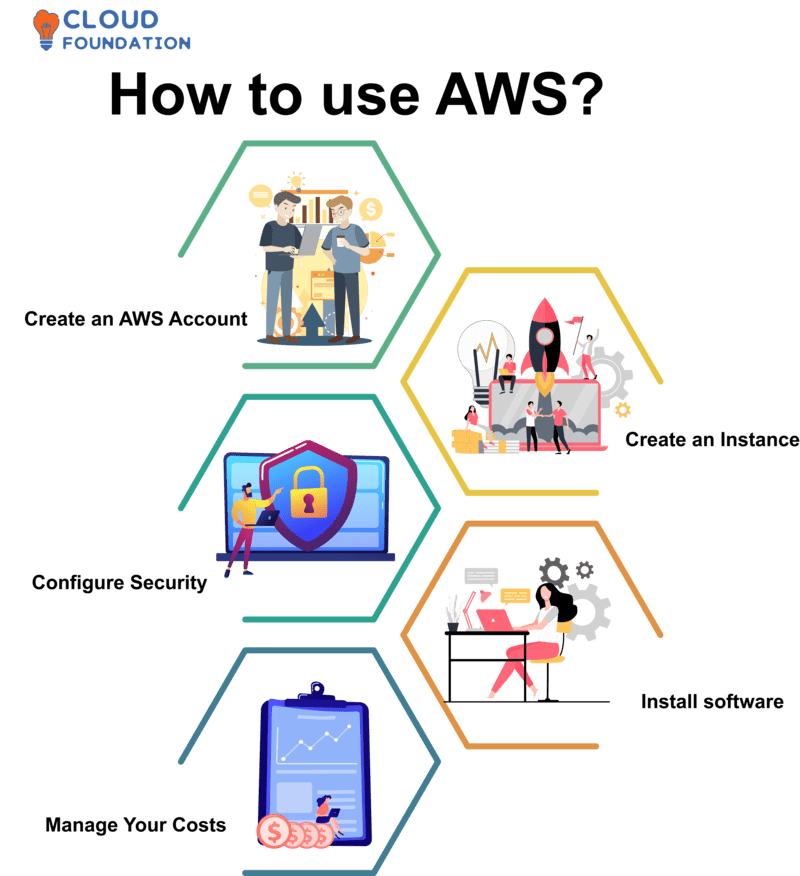What is Amazon Web Services (AWS) & What is EC2?
Make it a habit to check back often for helpful information and updates.
Our goal at AWS is to make digital transformation more accessible so businesses of all sizes and industries can benefit from the cloud’s scalability, flexibility, and cost-effectiveness.
Why do you keep stalling? So, shall we?
Amazon Web Services Tutorial for Beginners
AWS can keep the data in Storage; databases, analytics, machine learning, and application development are just some of the many services offered by Amazon Web Services (AWS), the company’s cloud computing platform.
When businesses throughout the globe need access to computing power, storage space, or services, they may turn to AWS.

Through AWS, users may lease processing time in Amazon’s massive cloud infrastructure. Elastic Compute Cloud (EC2), Simple Storage Service (S3), CloudWatch, and DynamoDB are only some services that may be used to manage applications and resources on AWS, and users can modify their usage as needed and be billed accordingly.
There are several services offered by AWS that help programmers create valuable applications.
Developers may execute code without worrying about server administration using AWS Lambda’s serverless computing technology and AWS CodeDeploy, CodeCommit, and CodePipeline for automatic application distribution across environments.
Managed services, such as Amazon Relational Database Service (RDS), Elastic Map Reduce (EMR), Redshift, and more, are available from AWS to simplify business-building cloud-based applications and systems.
These three give businesses access to cloud-based resources for creating and managing data.
AWS Marketplace allows customers to discover, acquire, and deploy pre-configured software solutions.
The AWS Marketplace is an online store where users may buy products and services from third-party developers of things like applications, operating systems, databases, and more.
Amazon Web Services (AWS) gives enterprises access to a whole suite of resources for handling and developing cloud-based software applications.
The cloud’s scalability, reliability, and low costs make AWS a prime platform for businesses looking to develop enticing consumer experiences.
AWS dummies can learn this AWS course without any pre-experience and from the AWS basics.
Now, we’re going to take a step toward mastering this tech.
What is Amazon Web Services?

Amazon Web Services (AWS) is a cloud computing platform offered by Amazon.com that provides various services and tools that enable organisations to develop apps at economical rates online.
These services and tools include server space, storage space, database space, networking software, analytics, and artificial intelligence.
AWS provides clients with web hosting, business infrastructure, and security services. Fast and cheap app development is possible with the help of AWS services like Elastic Compute Cloud (EC2), Simple Storage Service (S3), and Relational Database Service (RDS).
Customers may easily create AWS applications with little money on hardware or software.
Amazon’s machine learning technology can be used to create models or apps that predict user behaviour or spot abnormalities while suggesting products and services that are relevant to the user.
This is just one of the many popular cloud-based offerings that Amazon Web Services provides.
In sum, Amazon Web Services gives businesses access to a unified set of cloud services designed for rapidly developing and deploying applications with enhanced security and scalability at lower prices.
Define Amazon Web Services
Amazon Web Services (AWS) is its cloud computing offering. It is a collection of remote computing services that provide the technological infrastructure and AWS tools for distributed computing environments.

Its cornerstone services are Amazon EC2 for hosting virtual servers, S3 for managing storage space, and Route 53 for managing domain names.
Amazon Web Services allows businesses to create reliable, safe user applications. DevOps technologies simplify software development processes, while Identity and Access Management (IAM) and Amazon Guard Duty provide scalable security solutions and services for businesses of all sizes.
What does Amazon Web Services do, and what is Amazon Web Services used for?
Amazon Web Services (AWS) is a cloud-based information technology (IT) infrastructure and services offered through the Amazon Cloud Computing platform.
This includes computing services, storage solutions, databases, analytics, networking, artificial intelligence/machine learning, security, and mobile business apps.
Customers who use AWS have the potential to acquire access to a plethora of technical resources, including servers, software, storage space, databases, networking resources, etc., to assist with the expanding, growing, and measuring requirements of their businesses.

In addition to providing organisations with cloud access across IT infrastructure/services, AWS provides its clients with various IT resources.
With AWS’s security, analytics, and search capabilities, businesses can put their attention where it belongs to creating and launching new apps as quickly as possible while minimising costs.
Let’s dive into the inner workings of AWS today.
Amazon Web Services (AWS) is a cloud computing platform that provides a wide range of services, including data storage, analytics, Machine Learning, and content delivery.
Perfect for developers looking to deploy apps fast with minimal expenses, AWS services enable enterprises, government agencies, and other organisations to swiftly create and deploy cloud applications at lower prices without affecting operations and user experiences.
AWS was designed to scale with businesses, so it can now provide real-time service monitoring data and performance metrics that can be used to improve users’ experiences.
AWS may be used for many things, including creating and hosting websites, storing and analysing data, and virtualising cloud computers.
In addition to hosting and running a wide variety of applications, AWS can also be used to generate reports from extensive data analyses and to embed software into connected devices for machine learning, data storage, and video streaming, among many other tasks.

AWS Training

What is EC2 in AWS?
Elastic Compute Cloud (EC2) is a service provided by Amazon Web Services (AWS) that allows users to increase or decrease their cloud-based computing resources as needed.
Customers may quickly scale up or down their infrastructure through EC2’s rapid provisioning of new server instances.
EC2 users have a wide variety of options when it comes to memory, CPU, and other resources.

Users may get just the right amount of resources by selecting from a variety of AWS EC2 instance sizes.
“Amazon S3 and Amazon Elastic Block Store (EBS) are two additional storage alternatives for EC2 users.”
Amazon Elastic Block Store (EBS) helps operate extra databases and do backups.
AWS Architecture Overview
Amazon Web Services (AWS) offers services and tools that make it easier to create cloud applications that are secure, dependable, and inexpensive.
These services and tools include Amazon EC2, S3, Lambda, DynamoDB RDS SNS SQS CloudFormation Kinesis. Amazon S3 also provides hosting for various components on a pay-as-you-go basics.
The AWS architectural components are designed to cooperate to provide a complete service. Amazon Elastic Compute Cloud (Amazon EC2) is the foundation of AWS, providing the virtual machine instances required for creating and managing cloud applications.
Other services, such as serverless applications, microservices architecture, extensive data analysis, and artificial intelligence, may work together seamlessly when designing application structures.
What is AWS IAM?
By establishing and maintaining AWS users and groups and granting or revoking permissions on resources in AWS, you can tightly control who has access to what in AWS. AWS calls this its Identity and Access Management (IAM) web service.
It simplifies adding users and groups to your AWS account and controlling who has access to what resources.

It is critical to protect the AWS cloud using AWS IAM. To ensure that only authorised users or services can access AWS resources, you may use IAM rules to control who has access and how much.
Using IAM alerts and warnings, rule-based access control lets you keep tabs on user activity in real time and flag anything that seems questionable.
The many authentication methods and layers made possible by AWS IAM further tighten the system’s security.
What is AWS CloudFront?
AWS CloudFront can work on Websites, apps, and APIs that rely on CloudFront’s services and take advantage of its ability to optimisestatic and dynamic content delivery. Furthermore, it interfaces with Amazon S3, AWS EC2, Shield Lambda, and Route 53 to provide quicker deployment options for dynamic content from Amazon Web Services (AWS).
AWS IOT
While enhancing operations with data, analytics, and machine learning, AWS IoT is a managed cloud platform that enables connected devices to interface securely with cloud applications and other devices via protocols like MQTT or HTTPS.
Businesses can use AWS IoT to rapidly and easily create sophisticated IoT applications without the hassle of managing their connection infrastructure.

It executes code in response to events and distributes computer resources automatically, relieving developers of infrastructure tasks like server management so they may focus on building simple or complicated applications that use several services in concert.
What is AWS Amplify
To facilitate the rapid creation, deployment, and hosting of web and mobile applications that use AWS services, the AWS team has created a JavaScript library called AWS Amplify.
This library is aimed squarely at front-end and mobile developers creating cloud-enabled applications.

By standardising the creation of web and mobile applications, AWS Amplify simplifies the process of creating, deploying, and scaling cloud-enabled apps.
Secure multi-region hosting is simplified, and developers can access cutting-edge cloud services, including artificial intelligence services, storage analytics databases, and authentication.
What is AWS Kinesis
Web Hosting by Amazon Kinesis is an Amazon-managed cloud service streaming data platform collecting and analysingreal-time data from various applications and services.
It offers a simple API that accepts megabytes to exabytes per day of streaming data ingest. It can then be processed with AWS Lambda, Kinesis Data Analytics, or Amazon Machine Learning services, allowing businesses to quickly act on insights.
Quickly processing and analysing real-time streams of streaming data, Kinesis enables businesses to act on insights gathered promptly from real-time streaming applications.
AWS Cloud Computing
Amazon Web Services (AWS) is an advanced cloud computing platform that provides a variety of services to help businesses and organizations achieve their goals.
From small start-ups to large enterprises, AWS provides an effective, versatile, and cost-effective solution to meet the ever-increasing demands of today’s digital world.

Companies that use AWS can connect to its global server network for secure and trustworthy data access at all times and from any location on the planet.
Scalability is one of the key benefits of AWS, traditional computing systems require businesses to invest in costly hardware and software to keep up with their development. AWS easily reduces that investment cost.
Businesses can utilize AWS to swiftly change and scale down computing capabilities based on their computing needs, paying only for what they use, offering smaller businesses an even playing field when competing with bigger ones.
Another significant benefit of AWS is its versatility, organizations may choose the tools and functionality needed to develop and deploy applications from a wide range of services.
Amazon Web Services (AWS) offers a variety of services designed to suit even the most severe requirements, including storage, databases, and networking, as well as artificial intelligence and machine learning.
Amazon Web Services (AWS) also offers a high level of data security. AWS maintains an international team of security experts who continuously monitor its platform to ensure data protection.
Built-in features such as firewalls, encryption software, and identification and access control systems can help businesses improve their security posture.
In addition to facilitating the deployment of cloud-based applications and websites, storing data securely on its servers, managing networks efficiently, developing applications quickly, and gaining on-demand access to remote computing resources, AWS also gives its customers the flexibility to scale those resources up or down on the fly in response to fluctuating demand.
Services like serverless computing, machine learning data analytics, DevOps automation, and container services are just a few of the many offered by AWS.

AWS Online Training

AWS ECR
To safely and swiftly distribute Docker container images across many Amazon EC2 instances, customers may usethe AWS Elastic Container Registry (AWS ECR).
To further ensure the speedy and secure deployment of apps through containerisation using Kubernetes container images from AWS ECR, the service now includes resource-based permissions.
What is AWS DMS?
Amazon’s Database Migration Service (AWS DMS) is a web service on demand that moves data across servers.
In addition to Amazon DynamoDB and MongoDB, this web service is compatible with relational databases, including MySQL, PostgreSQL, Oracle, and SQL Server.
Machine Learning in AWS
The AWS Machine Learning process can be through hosted services that provide access to expert AI algorithms for rapid model training, design, and deployment of machine learning algorithms and models. Amazon Web Services’ Machine Learning service enables quick and affordable machine learning model development for developers and organisations.
Some examples of the machine learning tools offered by AWS Machine Learning include Amazon SageMaker, Amazon Comprehend, Amazon Forecast, Personalize, and Rekognition.

Amazon SageMaker provides an Integrated Development Environment (IDE) for developers and businesses to rapidly build, train, debug, and release machine learning models.
Using Amazon Comprehend, they can extract meaning from text in real time without writing any code.
Amazon Forecast is a tool for developers to foresee and anticipate future outcomes. Amazon Rekognition makes it easier for programmers to identify objects, people, and activities in photographs and videos. At the same time, Amazon Customise enables businesses to provide individualised user experiences across apps, websites, and devices.
What is Event Bridge in AWS?
With AWS Event Bridge, you can easily connect your on-premises applications with those hosted in the cloud.
Amazon S3, Kinesis, DynamoDB, and CloudWatch are some event sources it can keep up with and serve continuous real-time streams.
In this case, you may take action by using services like AWS SNS alerts, Amazon Kinesis Data Analytics applications, ECS Step Function state machines, and AWS Lambda functions.
How does Amazon Web Services Work?
Amazon Web Services (AWS) can function because it provides customers access to virtual servers, storage, compute resources, software applications, and services.
Most services are “provided as a service,” which means users pay only for what they consume, with costs scaling accordingly based on changes in requirements over time.
Customers can choose which services meet their needs by customising or adapting them with APIs, web-based interfaces, or command-line tools.

With no need for clients to install any physical infrastructure, AWS allows them to focus solely on providing their services without the burden of infrastructure management.
This is made possible by the company’s reliance on a global network of data centres connected by private fibre and low-latency networking services.
Customers have even more options for scalability and adaptability because of the third-party vendors that provide services and products that Amazon Web Services power.
Why Amazon Web Services?
Users of AWS have access to a wide variety of robust services that simplify the development of complicated applications with more scalability, reliability, and adaptability than is possible with conventional IT.
AWS allows customers to scale and cost-effectively implement cloud solutions uniquely tailored to their needs.
Customers may utilise AWS services to solve problems effectively as they build up workloads that evolve with their businesses, and they can take advantage of AWS’s pay-as-you-go pricing models to build reliable, cost-effective applications on the platform.
Their benefits allow businesses to concentrate on core activities for optimum performance in an environment of constant compliance and security.
While companies may concentrate on expanding their operations, AWS ensures that they comply with applicable laws and security standards.
Advantages of Amazon Web Services

Backup and Disaster Recovery Services: Amazon Web Services (AWS) may store data and provide access to recovery services while also protecting backup data.
Flexibility: Amazon Web Services allows clients to select services that best meet their requirements, giving businesses the power to tailor their data architecture precisely according to individual business goals.
Global Presence: Amazon Web Services’ global data centres ensure clients can accessthe required performance, making them accessible from multiple regions.
Security and Compliance Services: Amazon Web Services offers comprehensive security and compliance solutions to protect customer data.
Automation: Amazon Web Services’ services enable customers to automate manual activities like service deployment, resource provisioning and delivery, application setup/configuration, etc., on AWS.
What is Amazon Web Services software and how to use Amazon Web Services?
AWS can Storage, processing, analytics, networking services, mobile services, and many more functions are all available to users of a Cloud Computing platform.
Amazon Web Services (AWS), a division of Amazon, provides some of the most excellent cloud services available today at reasonable prices for companies of any size.
With AWS, even small businesses can afford to build, launch, and maintain their web-based applications.

Establish an AWS Account:Visit Amazon.com (the home of AWS) and sign up for an account. Make a Choice of Services Relevant to Your Needs Conduct thorough research of all AWS services to determine which best fits your application’s needs.
Create an Instance: Utilizing AWS, create an instance for your application using their interface by choosing account size, area size and platform platform options.
Configure Security: Setup SSH Keypairs, Network Access Restrictions and Security Groups on your instance to safeguard it against threats such as hackers
Install software:Before you install AWS Cloudwatch to monitor your instance’s health and performance, ensure you’ve downloaded and installed all the programs it needs to operate.
Manage Your Costs: Implement cost control systems like Amazon Cloudwatch to ensure resource utilisation efficiency and minimise unexpected charges, like Amazon Web Services modules.
Amazon Web Services modules
Compute Amazon EC2 (Elastic Compute Cloud): Cloud computing services that are scalable and safe.
Amazon Elastic Container Service (ECS): A container orchestration service that is highly scalable and performant.
AWS Lambda: Run programs without having to manage servers.
Amazon Light sail: Virtual private servers (VPS) that are simple to use.
Storage: Amazon S3 (Simple Storage Service): Object storage that is scalable and secure.
Amazon Elastic Block Store (EBS): Amazon EC2 persistent block storage.
Amazon Elastic File System (EFS): File storage that is simple and scalable for Amazon EC2.
Amazon Glacier: A low-cost data storage service.
Information databases:
Amazon Relational Database Service (RDS): A relational database that is managed and scalable.
Amazon DynamoDB: A robust and adaptable NoSQL database.
Amazon ElasticCache: A service for caching data in memory.
Amazon Virtual Private Cloud (VPC): A secure and isolated cloud environment.
Amazon Route 53: Domain Name System (DNS) Scalability.
Amazon CloudFront: A content distribution network (CDN).
Management Instruments:
Amazon CloudWatch: AWS service monitoring and management.
Amazon Web Services Identity and Access Management (IAM): Control user access and authentication.
AWS CloudFormation: AWS resource creation and management.
AWS Config: Track changes to AWS resource settings.
Security, Identity, and Compliance: Amazon Inspector: Assess security and compliance automatically.
AWS Certificate Manager: You may generate, administer, and roll out SSL/TLS certificates with the help of this service.
Amazon WAF: Protect web applications from cyber-attacks.
AWS Directory Service: Microsoft Active Directory hosting and management.
Migration and Transfer: – AWS Migration Hub: Track application and data migrations.
Amazon Web Services Migration Service: Migrate databases to AWS with little downtime.
AWS Snowball: Send and receive petabytes of data from and from AWS.
What are the best ways to learn Amazon Web Services?

Taking an Amazon Web Services (AWS) Certification Exam: By passing one of these examinations, individuals may attest to their proficiency in a particular area of AWS expertise, earning them respect and appreciation from employers.
Read AWS Documentation: Reading AWS documentation is an excellent method to learn more about Amazon Web Services (AWS) with the certification knowledge. Although most of AWS’s documentation is too technical for newcomers, taking the time to review each section of this document can help you become more familiar with AWS and its capabilities.
Attend Training Sessions: CloudFoundation provides AWS courses on topics like AWS. The information gained from attending one might be invaluable. And here you will be getting related issuessuch as technical AWS blogs and AWS training videos, which are more helpful to starting a career in AWS.
I hope this AWS blog has been helpful to you. Our support team will always be available if you have any questions during the training.
All the best.

AWS Course Price


Saniya
Author